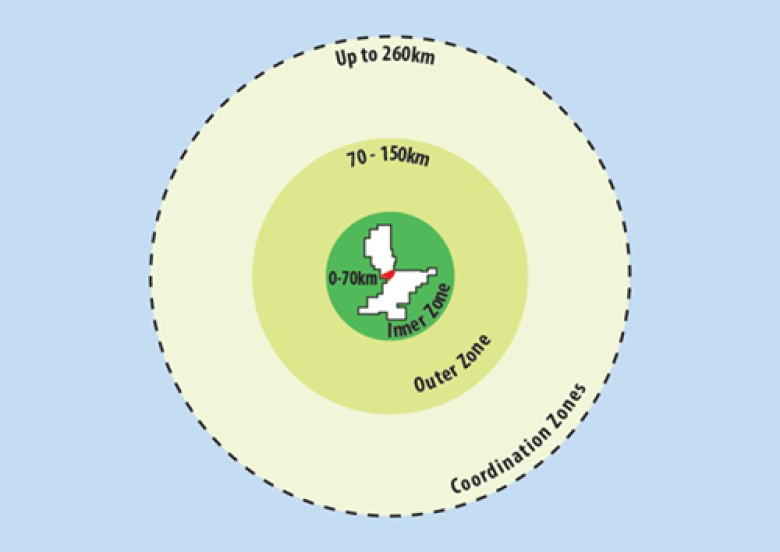Regulations
Under regulations put in place by the Australian Communications and Media Authority (ACMA) and the Western Australian Department of Mines, Industry Regulation and Safety (DMIRS) there are specific requirements for each of these zones.
Inner Zone (0–70 km)
Radio astronomy is the primary user of radiofrequency spectrum in this zone. Other radio users are secondary to radio astronomy use.
The following legislative, regulatory and policy instruments reflect these priorities:
Outer Zone (70–150 km)
In this zone, the governments endeavour to maximise opportunities for coexistence between radio astronomy and other activities such as mining and pastoralism.
This is consistent with the Radiocommunications (Mid West Radio Quiet Zone) Frequency Band Plan 2011 and RALI MS 32.
Coordination Zones (up to 260 km radius)
A number of Coordination Zones extend the radio quiet zone up to a 260 km radius (depending on frequency), as specified by the ACMA in Radiocommunications Assignment and Licensing Instruction (RALI) MS 32.
Mining and exploration
If you are carrying out exploration and mining within the Inner Zone (70 km radius) you must submit a Radio Emissions Management Plan to the DMIRS for approval, in accordance with the RTMRMA. The plan must demonstrate that the proposed operation will be consistent with radio-astronomy requirements.
For mining within the ARQZWA, DMIRS have reserved two areas of land under Section 19 of the Mining Act (WA) which are exempt from the granting of mining tenements.
Find out more from the SKA project page on the DMIRS website.
Licences for radiocommunications transmitters
Using a radio transmitter in Australia legally requires one of three types of licences. Within the radio quiet zone the ACMA regulates these licences as follows:
Apparatus licences
Commercial or large radio installations use apparatus licences. Some examples include:
- satellite earth stations
- television or radio broadcast towers
- point-to-point radio links
- radar
- amateur radio
- maritime and aeronautical radiocommunications.
If you are applying for apparatus licences in the ARQZWA, consult with the MRO Entity about the impact of the proposed transmitter on radio astronomy. If interference from your proposed transmitter in the coexistence zone would exceed the thresholds specified in the regulations, you are required to undertake measures to reduce interference to acceptable levels.
Relevant procedures and interference thresholds are in the:
Class licences
Class licences are automatically applied to most common low-power radio devices including:
- CB radios
- satellite phones
- wireless monitoring systems
- WiFi
- Bluetooth.
Within the Inner Zone (70 km radius), relevant class licences contain conditions to prevent interference with radio astronomy. These conditions require that use of a class-licensed device must stop if the CSIRO notifies the operator that it is causing interference to radio astronomy.
Spectrum licences
Spectrum licences typically apply to a group of transmitters operated by service providers such as mobile telephone companies rather than individual installations. The ACMA has placed conditions on relevant spectrum licences to limit interference to radio astronomy.
For more information contact the ACMA.
Emergency situations
Throughout Australia, including within the ARQZWA, the Radiocommunications Act 1992 allows you to use radiocommunication devices in urgent situations involving safety of life, major environmental threats or significant damage to property.
Facilitating coexistence
Within the Outer Zone (70–150 km radius), the goal of the governments is for both radio astronomy and other activities to be successfully undertaken to maximise opportunities to the region. While still protecting radio astronomy, we work with industry and the scientific community to facilitate continued development and viability of other economic activities in the region. We do this by encouraging negotiation of mutually agreeable strategies to control radio-frequency interference. Follow the process described in RALI MS 32.
If you’re planning an activity requiring radiocommunication licences in the ARQZWA, contact CSIRO at atnf-spectrum@csiro.au.

